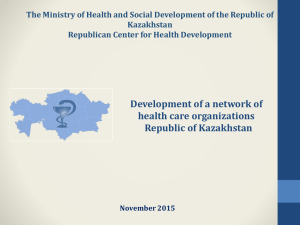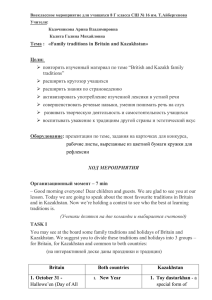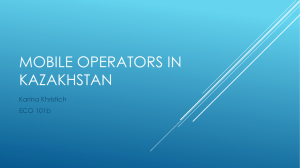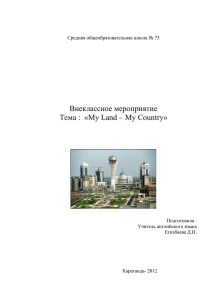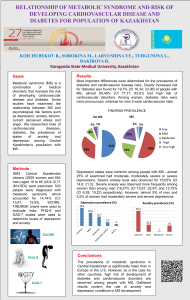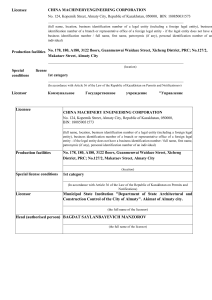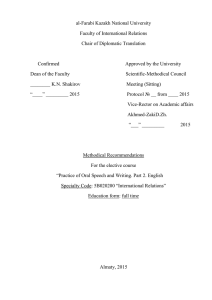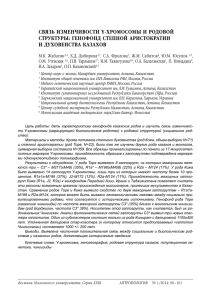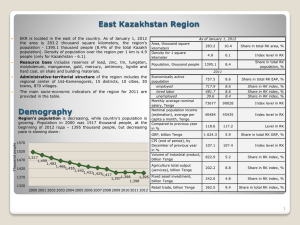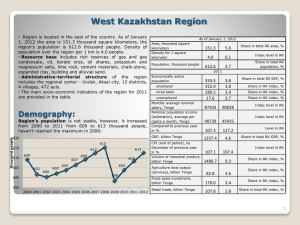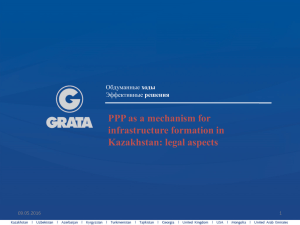Social media, online activism and government control in Kazakhstan
реклама
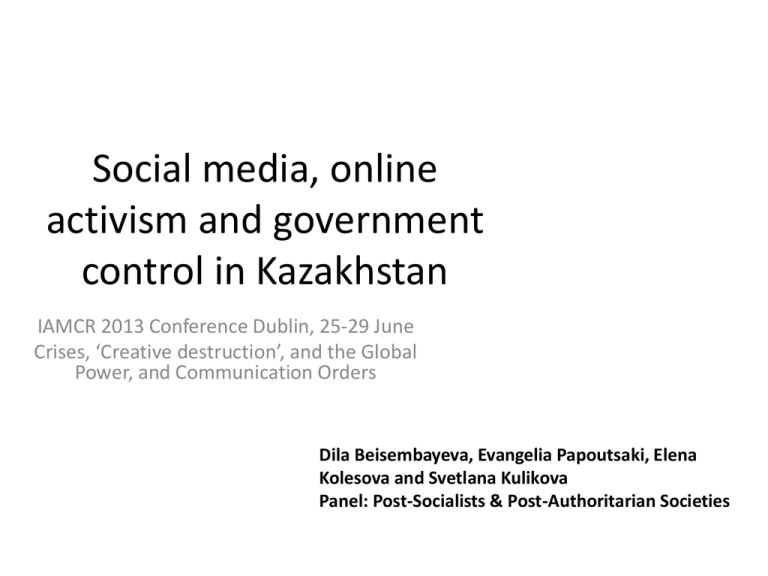
Social media, online activism and government control in Kazakhstan IAMCR 2013 Conference Dublin, 25-29 June Crises, ‘Creative destruction’, and the Global Power, and Communication Orders Dila Beisembayeva, Evangelia Papoutsaki, Elena Kolesova and Svetlana Kulikova Panel: Post-Socialists & Post-Authoritarian Societies Research overview • Preliminary findings from an on-going research project on the role of online social media and activism in political processes and political participation in Kazakhstan • Events in Zhanaozen in 2011 is used as a case study • Methodology used – content analysis as well as discourse analysis at a later stage • ‘Mapping’ of the content of the Kazakh blogosphere • Framing theory as analytical tool Background information 16th of December, 2011 – the worst civic conflict in the post-soviet history of Kazakhstan during the celebrations of the 20th anniversary of Kazakhstan’s independence in Zhanaozen 16 people killed and over 100 injured Nazarbayev imposes state of emergency in the town of Zhanaozen, and all forms of communication with the rest of the country were cut off, including mobile and internet services • A video demonstrating the police marching towards the civilians and then opening fire is uploaded to YouTube, which led to the opening of the criminal investigation by the Prosecutor General’s office • The Prime Minister of Kazakhstan at the time – Massimov, invited country’s popular bloggers to Zhanaozen • This triggered an opposition group of bloggers to form their own team to visit the town Media, Internet and Censorship in Kazakhstan • Kazakhstan declared independence on the 16th of December of 1991 • Nursultan Nazarbayev became Kazakhstan’s first president, a position he still retains today • Despite the high hopes after the dissolution of the Soviet Union, Kazakhstan is still viewed as an authoritarian state • 2,500 regularly published newspapers and magazines – 80% of which are private • 238 representatives of online media, as well as 100 TV and radio stations • Kazakhstan ranks 182nd out of 196 countries and 26th out of the 29 former Soviet states for press freedom Media, Internet and Censorship in Kazakhstan • In 2012, 40 opposition media outlet were banned • As a result, it has been suggested by RWB that Nazarbayev’s government ‘moved closer to the ultra-authoritarian model of Uzbekistan and Turkmenistan’ • Initially, Kazakhstan’s government considered the internet as a new source of strengthening its economic position in Central Asia by becoming the region’s information-technology hub • In 2012, Kazakhstan ranked was at the top in terms of ICT and digital uptake amongst the CIS states • However, the government realised the democratising power of the internet and tried to control access to it • In addition, Kazakhstan is now looking at mechanisms to control social networking sites in order to prevent ‘extremist’ actions – like those seen in Tunisia and Egypt Methodology • Explanatory research – preliminary findings • Stage one – ‘mapping’ of the blogging sites content and participation to identify netizens’ activities in Kazakhstan’s blogosphere » Qualitative oriented content analysis which examined significant aspects of the text • Stage two – framing theory used as an analytical tool to understand the role of social media on political processes in Kazakhstan by analysing information posted online as well as of that published in Kazakhstan’s press • Stare three – discourse analysis Data collection • Data was collected of a period of three months from 16 December 2011 (when the events started) to 27 March 2012 (when the trials of the 37 oil workers began) • Blogging websites Yvision and LiveJournal were primary focus of analysis due to their popularity in the Kazakhstan’s blogosphere • Two national newspapers – Kazakhstanskaya Pravda and Respublika, as well as the online version of the Respublika were included too as they both represented the mainstream traditional media. These newspapers provided a comparative context against which the blogging sites are positioned in terms of context Identifying data categories • A two stage content analysis was conducted: – First stage – general mapping of content and participants – Five questions were developed for the initial content analysis which generated separate themes with subthemes • • • • • How was the conflict in Zhanaozen framed? Who was the voice of the events? What is the story subject of the news reports/blogs? What story sources are used? What is the main language of blogging? • The early mapping of content and participants identified the following three main groups of bloggers: – Those selected by the government, also known as the ‘bloody bloggers’ – Those who went on a trip to Zhanaozen independently, as called by others the ‘free bloggers’ – And the remaining bloggers who either supported the first of the second group or remained neutral Framing of the conflict - bloggers Socio-economic issues “Сейчас уже всем стало ясно, что Правительство Масимова не в состоянии справиться с возложенными на него обязаностями. Обманутые дольщики, разорение села, стагнация промышленности и как жирная кровавая точка: Жанаозень”. Law and (dis)order 15% 37% 10% 8% Political instability caused by the opposition in exile Political instability caused by the internal force Conspiracy 13% 17% Other “Если кто не в курсе что в Жанаозене случилось – короче рабочие-нефтянники обнаружили подлог – в «жировках» (так они называют ведомости по зарплатам) на местах суммы оказались вдвое-втрое меньше чем в бумагах в головном офисе. И хоть зарплаты у них не маленькие – возмутились. Вышли на митинг, отдайте говорят нам наши деньги и стояли семь(!) месяцев” Findings The Voice - bloggers 13% Government/Army/Police/Prosecutor General's Office 12% The Oil Company - KazMunaiGaz 50% Political opposition Protesters 25% Story subjects - bloggers Discussions about social networking websites “После событий в Жанаозене мне звонили нефтяники с просьбой отключить их от smsрассылки«Твиттера». Слезно просили, потому что силовики жестко проверяли тех, кто использует «Твиттер», «Фейсбук» в Жанаозене” 25% 46% Socio-economic issues 29% Role of printed media and TV in covering the events in Zhanaozen Findings Framing of the conflict – mainstream media 0% Socio-economic issues 9% 18% Law and (dis)order 23% Political instability caused by the opposition in exile Political instability caused by the internal force 5% Conspiracy 45% Other Findings The Voice - mainstream media 24% Government/Army/Police/Prosecutor General's Office The Oil Company - KazMunaiGaz 48% Political opposition Protesters 19% 9% Where to from here? “Интернет сегодня дает возможность сформировать в общественном сознании такую картину происходящего, которая будет альтернативна картинке, транслируемой властью через телевизор. И дальше такое противостояние будет только усиливаться, если власть не изменит своей информационной политики” • The old authoritarian method dealing with social and political unrest by cutting the place off from the outside world no longer works in Kazakhstan • Political activists mobilised online social media to inform the nation and the world of the uprising in Zhanaozen • Kazakhstan’s government mobilised to find effective ways to control online social media to transmit the official message and state ideology • What do online social activism and the emerging public sphere tell us about the changing nature of the Kazakh society? Questions?
